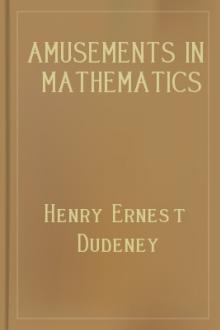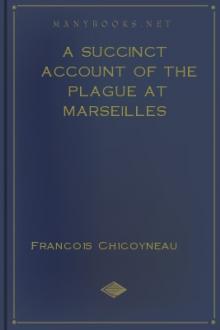Amusements in Mathematics by Henry Ernest Dudeney (e books for reading txt) 📖

- Author: Henry Ernest Dudeney
- Performer: 0486204731
Book online «Amusements in Mathematics by Henry Ernest Dudeney (e books for reading txt) 📖». Author Henry Ernest Dudeney
The word "labyrinth" is derived from a Greek word signifying the passages of a mine. The ancient mines of Greece and elsewhere inspired fear and awe on account of their darkness and the danger of getting lost in their intricate passages. Legend was afterwards built round these mazes. The most familiar instance is the labyrinth made by Dædalus in Crete for King Minos. In the centre was placed the Minotaur, and no one who entered could find his way out again, but became the prey of the monster. Seven youths and seven maidens were sent regularly by the Athenians, and were duly devoured, until Theseus slew the monster and escaped from the maze by aid of the clue of thread provided by Ariadne; which accounts for our using to-day the expression "threading a maze."
The various forms of construction of mazes include complicated ranges of caverns, architectural labyrinths, or sepulchral buildings, tortuous devices indicated by coloured marbles and tiled pavements, winding paths cut in the turf, and topiary mazes formed by clipped hedges. As a matter of fact, they may be said to have descended to us in precisely this order of variety.
Mazes were used as ornaments on the state robes of Christian emperors before the ninth century, and were soon adopted in the decoration of cathedrals and other churches. The original idea was doubtless to employ them as symbols of the complicated folds of sin by which man is surrounded. They began to abound in the early part of the twelfth century, and I give an illustration of one of this period in the parish church at St. Quentin (Fig. 1). It formed a pavement of the nave, and its diameter is 34½ feet. The path here is the line itself. If you place your pencil at the point A and ignore the enclosing line, the line leads you to the centre by a long route over the entire area; but you never have any option as to direction during your course. As we shall find in similar cases, these early ecclesiastical mazes were generally not of a puzzle nature, but simply long, winding paths that took you over practically all the ground enclosed.
 FIG. 1.—Maze at St. Quentin.
FIG. 1.—Maze at St. Quentin.
In the abbey church of St. Berlin, at St. Omer, is another of these curious floors, representing the Temple of Jerusalem, with stations for pilgrims. These mazes were actually visited and traversed by them as a compromise for not going to the Holy Land in fulfilment of a vow. They were also used as a means of penance, the penitent frequently being directed to go the whole course of the maze on hands and knees.
 FIG. 2.—Maze in Chartres Cathedral.
FIG. 2.—Maze in Chartres Cathedral.
The maze in Chartres Cathedral, of which I give an illustration (Fig. 2), is 40 feet across, and was used by penitents following the procession of Calvary. A labyrinth in Amiens Cathedral was octagonal, similar to that at St. Quentin, measuring 42 feet across. It bore the date 1288, but was destroyed in 1708. In the chapter-house at Bayeux is a labyrinth formed of tiles, red, black, and encaustic, with a pattern of brown and yellow. Dr. Ducarel, in his "Tour through Part of Normandy" (printed in 1767), mentions the floor of the great guard-chamber in the abbey of St. Stephen, at Caen, "the middle whereof represents a maze or labyrinth about 10 feet diameter, and so artfully contrived that, were we to suppose a man following all the intricate meanders of its volutes, he could not travel less than a mile before he got from one end to the other."
 FIG. 3.—Maze in Lucca Cathedral.
FIG. 3.—Maze in Lucca Cathedral.
Then these mazes were sometimes reduced in size and represented on a single tile (Fig. 3). I give an example from Lucca Cathedral. It is on one of the porch piers, and is 19½ inches in diameter. A writer in 1858 says that, "from the continual attrition it has received from thousands of tracing fingers, a central group of Theseus and the Minotaur has now been very nearly effaced." Other examples were, and perhaps still are, to be found in the Abbey of Toussarts, at Châlons-sur-Marne, in the very ancient church of St. Michele at Pavia, at Aix in Provence, in the cathedrals of Poitiers, Rheims, and Arras, in the church of Santa Maria in Aquiro in Rome, in San Vitale at Ravenna, in the Roman mosaic pavement found at Salzburg, and elsewhere. These mazes were sometimes called "Chemins de Jerusalem," as being emblematical of the difficulties attending a journey to the earthly Jerusalem and of those encountered by the Christian before he can reach the heavenly Jerusalem—where the centre was frequently called "Ciel."
Common as these mazes were upon the Continent, it is probable that no example is to be found in any English church; at least I am not aware of the existence of any. But almost every county has, or has had, its specimens of mazes cut in the turf. Though these are frequently known as "miz-mazes" or "mize-mazes," it is not uncommon to find them locally called "Troy-towns," "shepherds' races," or "Julian's Bowers"—names that are misleading, as suggesting a false origin. From the facts alone that many of these English turf mazes are clearly copied from those in the Continental churches, and practically all are found close to some ecclesiastical building or near the site of an ancient one, we may regard it as certain that they were of church origin and not invented by the shepherds or other rustics. And curiously enough, these turf mazes are apparently unknown on the Continent. They are distinctly mentioned by Shakespeare:—
And the quaint mazes in the wanton green
For lack of tread are undistinguishable."
Through forth-rights and meanders!"
There was such a maze at Comberton, in Cambridgeshire, and another, locally called the "miz-maze," at Leigh, in Dorset. The latter was on the highest part of a field on the top of a hill, a quarter of a mile from the village, and was slightly hollow in the middle and enclosed by a bank about 3 feet high. It was circular, and was thirty paces in diameter. In 1868 the turf had grown over the little trenches, and it was then impossible to trace the paths of the maze. The Comberton one was at the same date believed to be perfect, but whether either or both have now disappeared I cannot say. Nor have I been able to verify the existence or non-existence of the other examples of which I am able to give illustrations. I shall therefore write of them all in the past tense, retaining the hope that some are still preserved.
 FIG. 4.—Maze at Saffron Walden, Essex.
FIG. 4.—Maze at Saffron Walden, Essex.
In the next two mazes given—that at Saffron Walden, Essex (110 feet in diameter, Fig. 4), and the one near St. Anne's Well, at Sneinton, Nottinghamshire (Fig. 5), which was ploughed up on February 27th, 1797 (51 feet in diameter, with a path 535 yards long)—the paths must in each case be understood to be on the lines, black or white, as the case may be.
 FIG. 5.—Maze at Sneinton, Nottinghamshire.
FIG. 5.—Maze at Sneinton, Nottinghamshire.
 FIG. 6.—Maze at Alkborough, Lincolnshire.
FIG. 6.—Maze at Alkborough, Lincolnshire.
I give in Fig. 6 a maze that was at Alkborough, Lincolnshire, overlooking the Humber. This was 44 feet in diameter, and the resemblance between it and the mazes at Chartres and Lucca (Figs. 2 and 3) will be at once perceived. A maze at Boughton Green, in Nottinghamshire, a place celebrated at one time for its fair (Fig. 7), was 37 feet in diameter. I also include the plan (Fig. 8) of one that used to be on the outskirts of the village of Wing, near Uppingham, Rutlandshire. This maze was 40 feet in diameter.
 FIG. 7.—Maze at Boughton Green, Nottinghamshire.
FIG. 7.—Maze at Boughton Green, Nottinghamshire.
 FIG. 8.—Maze at Wing, Rutlandshire.
FIG. 8.—Maze at Wing, Rutlandshire.
 FIG. 9.—Maze on St. Catherine's Hill, Winchester.
FIG. 9.—Maze on St. Catherine's Hill, Winchester.
The maze that was on St. Catherine's Hill, Winchester, in the parish of Chilcombe, was a poor specimen (Fig. 9), since, as will be seen, there was one short direct route to the centre, unless, as in Fig. 10 again, the path is the line itself from end to end. This maze was 86 feet square, cut in the turf, and was locally known as the "Mize-maze." It became very indistinct about 1858, and was then recut by the Warden of Winchester, with the aid of a plan possessed by a lady living in the neighbourhood.
 FIG. 10.—Maze on Ripon Common.
FIG. 10.—Maze on Ripon Common.
A maze formerly existed on Ripon Common, in Yorkshire (Fig. 10). It was ploughed up in 1827, but its plan was fortunately preserved. This example was 20 yards in diameter, and its path is said to have been 407 yards long.
 FIG. 11.—Maze at Theobalds, Hertfordshire.
FIG. 11.—Maze at Theobalds, Hertfordshire.
In the case of the maze at Theobalds, Hertfordshire, after you have found the entrance within the four enclosing hedges, the path is forced (Fig. 11). As further illustrations of this class of maze, I give one taken from an Italian work on architecture by Serlio, published in 1537 (Fig. 12), and one by London and Wise, the designers of the Hampton Court maze, from their book, The Retired Gard'ner, published in 1706 (Fig. 13). Also, I add a Dutch maze (Fig. 14).
 FIG. 12.—Italian Maze of Sixteenth Century.
FIG. 12.—Italian Maze of Sixteenth Century.
 FIG. 13.—By the Designers of Hampton Court Maze.
FIG. 13.—By the Designers of Hampton Court Maze.
 FIG. 14.—A Dutch Maze.
FIG. 14.—A Dutch Maze.
So far our mazes have been of historical interest, but they have presented no difficulty in threading. After the Reformation period we find mazes converted into mediums for recreation, and they generally consisted of labyrinthine paths enclosed by thick and carefully trimmed hedges. These topiary hedges were known to the Romans, with whom the topiarius was the ornamental gardener. This type of maze has of late years degenerated into the seaside "Puzzle Gardens. Teas, sixpence, including admission to the Maze." The Hampton Court Maze, sometimes called the "Wilderness," at the royal palace, was designed, as I have said, by London and Wise for William III., who had a liking for such things (Fig. 15). I have before me some three or four versions of it, all slightly different from one another; but the plan I select is taken from an old guide-book to the palace, and therefore ought to be trustworthy. The meaning of the dotted lines, etc., will be explained later on.
 FIG. 15.—Maze at Hampton Court Palace.
FIG. 15.—Maze at Hampton Court Palace.
 FIG. 16.—Maze at Hatfield House, Herts.
FIG. 16.—Maze at Hatfield House, Herts.
The maze at Hatfield House (Fig.





Comments (0)